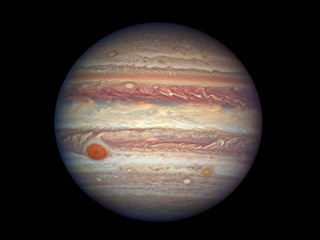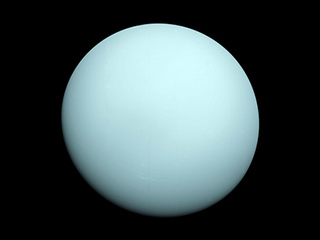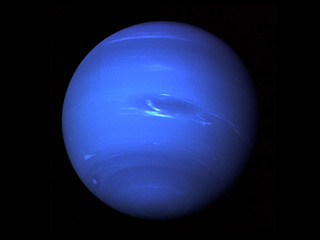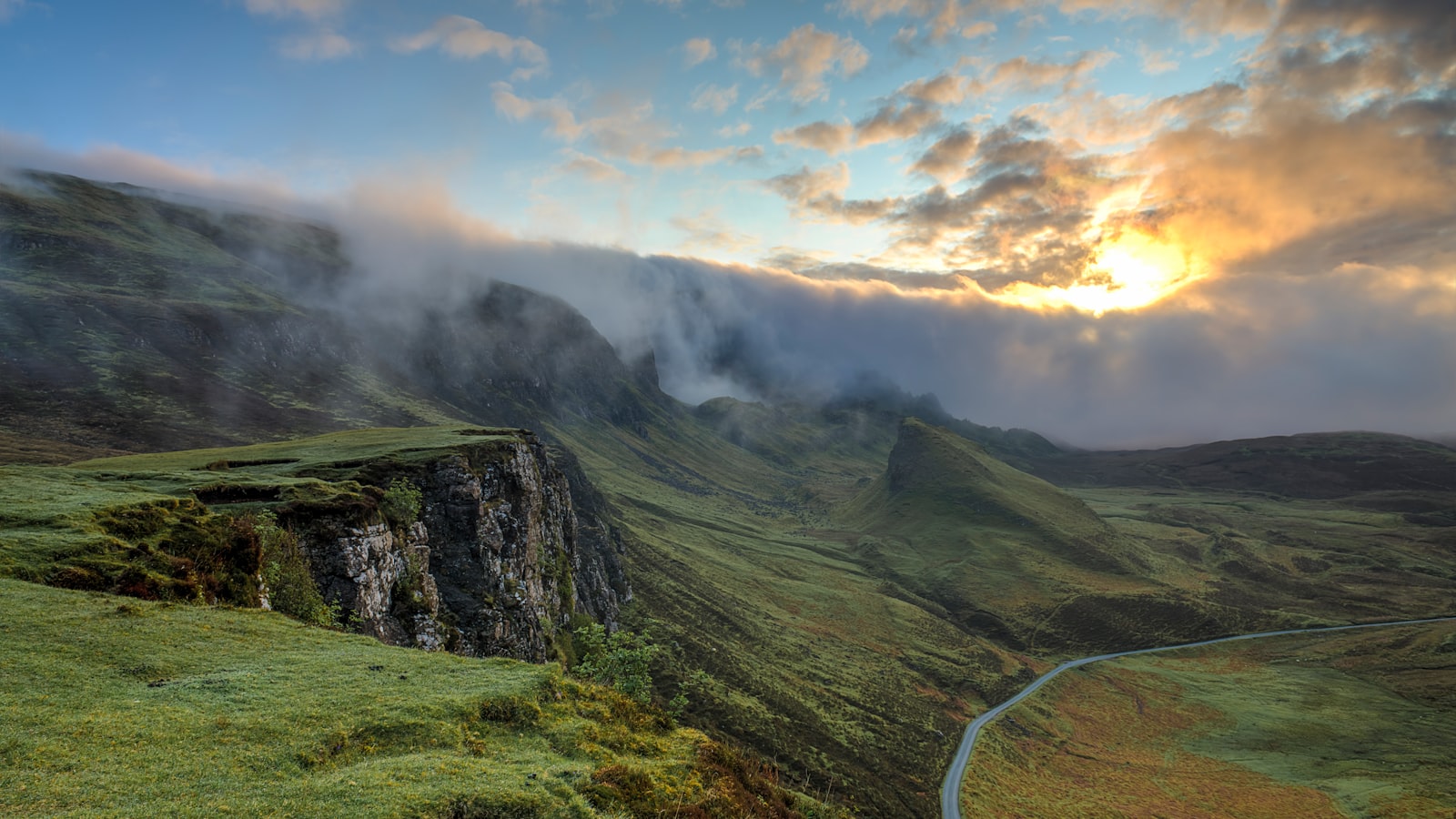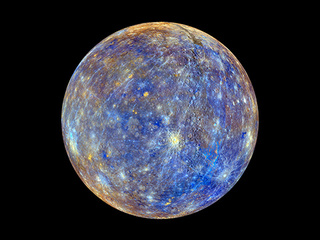
Mercury
The smallest planet in our solar system and nearest to the Sun, Mercury is only slightly larger than Earth's Moon. From the surface of Mercury, the Sun would appear more than three times as large as it does when viewed from Earth, and the sunlight would be as much as seven times brighter. Despite its proximity to the Sun, Mercury is not the hottest planet in our solar system – that title belongs to nearby Venus, thanks to its dense atmosphere. But Mercury is the fastest planet, zipping around the Sun every 88 Earth days. Mercury is appropriately named for the swiftest of the ancient Roman gods.With a radius of 1,516 miles (2,440 kilometers), Mercury is a little more than 1/3 the width of Earth. If Earth were the size of a nickel, Mercury would be about as big as a blueberry. From an average distance of 36 million miles (58 million kilometers), Mercury is 0.4 astronomical units away from the Sun. One astronomical unit (abbreviated as AU), is the distance from the Sun to Earth. From this distance, it takes sunlight 3.2 minutes to travel from the Sun to MercuryMercury is the second densest planet, after Earth. It has a large metallic core with a radius of about 1,289 miles (2,074 kilometers), about 85 percent of the planet's radius. There is evidence that it is partly molten, or liquid. Mercury's outer shell, comparable to Earth's outer shell (called the mantle and crust), is only about 400 kilometers (250 miles) thick. Formation Mercury formed about 4.5 billion years ago when gravity pulled swirling gas and dust together to form this small planet nearest the Sun. Like its fellow terrestrial planets, Mercury has a central core, a rocky mantle and a solid crust..
Last updated 3 mins ago
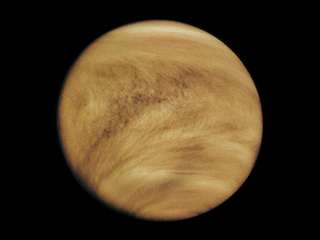
Venus
Venus is the second planet from the Sun and is Earth’s closest planetary neighbor. It’s one of the four inner, terrestrial (or rocky) planets, and it’s often called Earth’s twin because it’s similar in size and density. These are not identical twins, however – there are radical differences between the two worlds. The Latest NASA Balloon Detects California Earthquake – Next Stop, Venus? Venus Resources Venus has a thick, toxic atmosphere filled with carbon dioxide and it’s perpetually shrouded in thick, yellowish clouds of sulfuric acid that trap heat, causing a runaway greenhouse effect. It’s the hottest planet in our solar system, even though Mercury is closer to the Sun. Surface temperatures on Venus are about 900 degrees Fahrenheit (475 degrees Celsius) – hot enough to melt lead. The surface is a rusty color and it’s peppered with intensely crunched mountains and thousands of large volcanoes. Scientists think it’s possible some volcanoes are still active. Venus has crushing air pressure at its surface – more than 90 times that of Earth – similar to the pressure you'd encounter a mile below the ocean on Earth. Another big difference from Earth – Venus rotates on its axis backward, compared to most of the other planets in the solar system. This means that, on Venus, the Sun rises in the west and sets in the east, opposite to what we experience on Earth. (It’s not the only planet in our solar system with such an oddball rotation – Uranus spins on its side.) Venus was the first planet to be explored by a spacecraft – NASA’s Mariner 2 successfully flew by and scanned the cloud-covered world on Dec. 14, 1962. Since then, numerous spacecraft from the U.S. and other space agencies have explored Venus, including NASA’s Magellan, which mapped the planet's surface with radar. Soviet spacecraft made the most successful landings on the surface of Venus to date, but they didn’t survive long due to the extreme heat and crushing pressure. An American probe, one of NASA's Pioneer Venus Multiprobes, survived for about an hour after impacting the surface in 1978.
Last updated 3 mins ago

Earth
Orbit and Rotation As Earth orbits the Sun, it completes one rotation every 23.9 hours. It takes 365.25 days to complete one trip around the Sun. That extra quarter of a day presents a challenge to our calendar system, which counts one year as 365 days. To keep our yearly calendars consistent with our orbit around the Sun, every four years we add one day. That day is called a leap day, and the year it's added to is called a leap year. Earth's axis of rotation is tilted 23.4 degrees with respect to the plane of Earth's orbit around the Sun. This tilt causes our yearly cycle of seasons. During part of the year, the northern hemisphere is tilted toward the Sun and the southern hemisphere is tilted away. With the Sun higher in the sky, solar heating is greater in the north producing summer there. Less direct solar heating produces winter in the south. Six months later, the situation is reversed. When spring and fall begin, both hemispheres receive roughly equal amounts of heat from the Sun. Structure Earth is composed of four main layers, starting with an inner core at the planet's center, enveloped by the outer core, mantle and crust. The inner core is a solid sphere made of iron and nickel metals about 759 miles (1,221 kilometers) in radius. There the temperature is as high as 9,800 degrees Fahrenheit (5,400 degrees Celsius). Surrounding the inner core is the outer core. This layer is about 1,400 miles (2,300 kilometers) thick, made of iron and nickel fluids. In between the outer core and crust is the mantle, the thickest layer. This hot, viscous mixture of molten rock is about 1,800 miles (2,900 kilometers) thick and has the consistency of caramel. The outermost layer, Earth's crust, goes about 19 miles (30 kilometers) deep on average on land. At the bottom of the ocean, the crust is thinner and extends about 3 miles (5 kilometers) from the sea floor to the top of the mantle. Formation When the solar system settled into its current layout about 4.5 billion years ago, Earth formed when gravity pulled swirling gas and dust in to become the third planet from the Sun. Like its fellow terrestrial planets, Earth has a central core, a rocky mantle and a solid crust..
Last updated 3 mins ago

